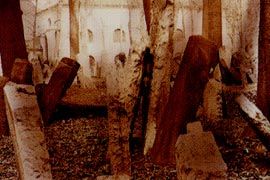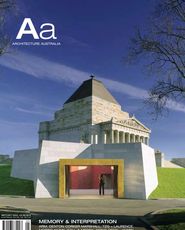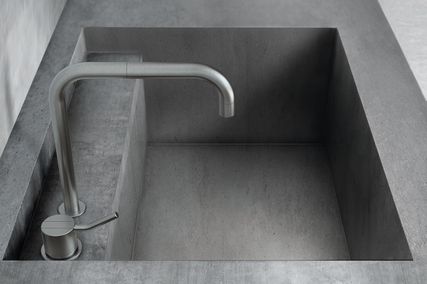PHOTOGRAPHY JANET LAURENCE
Even now when I try to remember…, the darkness does not lift but becomes yet heavier as I think how little we can hold in mind, how everything is constantly lapsing into oblivion with extinguished life, how the world is, as it were, draining itself, in that the history of countless places and objects which themselves have no power of memory, never heard, never described or passed on.%br% W. G. SEBALD%br%%br% Art should speak to us across the centuries, it is the means by which we break bread with the dead.%br% W. H. AUDEN%br%%br% Connective aesthetics strikes at the root of this alienation by dissolving the mechanical division between self and the world that has prevailed during the modern epoch. World healing begins with the individual who welcomes the other.%br% REBECCA HORN%br%%br% Beyond the physicality of architectural objects and practicalities of programmatic content, enmeshed experience is not merely a place of events, things and activities, but something more intangible which merges from the continuous unfolding or overlapping spaces, materials and detail.%br% MAURICE MERLEAU PONTY%br%%br% The authenticity of architectural experience is grounded in the tech-tonic language of construction and its comprehensibility to the senses. We behold, touch and measure the world with our entire bodily existence, and the experiential world is organised and articulated around the centre of the body. We are in constant dialogue and interaction with the environment so that it is impossible to detach the image of the self from its spatial and situational existence.%br% MAURICE MERLEAU PONTY%br%%br% Every era has to reinvent the project of “spirituality” for itself…. In the modern era, one of the most active metaphors for the spiritual project is “art”. The activities of the painter, the musician, the poet, the dancer, once they were grouped together under that generic name (a relatively recent move), have proved a particularly adaptable site on which to stage the formal dramas besetting consciousness…%br% SUSAN SONTAG


WE ARE IN THE midst of a worldwide obsession with memorializing that has been unequalled since the age of the dictators. Monuments, public sculptures, commemorative sites and museums are being created at an accelerated pace. From the crosses and flowers left by the roadside as transient memorials to the accidentally dead, to the transformation of “the world’s largest building project” – the rebuilt World Trade Centre – into a huge functioning memorial, everywhere are found new spaces dedicated to the commemoration of the past, and usually a past involving violent death.
The current multitude of memorial designs can be compared to the 1920s, when a World War 1 memorial was built in every Australian town, paid for by local subscription, and usually not artistically advanced. Then the issues seemed less complex and were backed by very widespread support for the war and the involvement of Australia. A simple message was voiced by almost the entire community, united in grief and pride.
The recent search for meaning is genuine, and is once again felt across the community. It can be seen as a response to our challenging times and their complex issues, but it is also the result of a craving for immortality – the desire to make an event live beyond the life of those who were affected by it. The creators of memorials build an image of immortality, often inflating the event’s importance. Every memorial says, “This is worth remembering”. This need for endurance is reflected in the physicality of memorials, which are among the very few works still designed to be lasting.
Once, this materialization of memory and the spirit was evoked by religious buildings, spaces where memory and the spirit were housed, eloquently and enduringly, in architecture. With the re-evaluation of religion and the marginalization of most church design, it is now secular spaces that have this crucial function. Some recent monumental public architecture tends towards making functioning buildings fulfil a memorializing role, giving space within our cities and towns for the necessary release and reflection. This role was perhaps pioneered with C. E.W. Bean’s concept for the Australian War Memorial – a nationally significant memorial within a large museum.
Other examples range from the new National Museum of Australia with its Aboriginal and cultural memorializing and references to lost landscapes and ideals, to Libeskind’s Jewish Museum in Berlin, where the memorial function has overtaken the building’s primary object as a museum.
Think of the privileging of memory – with the potential impact on perception and temporality of new media – in both contemporary architecture and the object.
Philosopher Hermann Lübbe describes “musealisation” as central to the shifting temporal sensibility of our times, a shift which infiltrates all modes of our life. He identifies an expansive historicism in contemporary culture, which provides a bulwark against obsolescence and disappearance, and counters our deep anxiety about the speed of change and the ever-shrinking horizons of time and space.
The physical expression of life and death in memorials is both overt and deep. The romantics thought that memory bound us in a deep sense of the past, associated with melancholia, but today we think of memory as a mode of re-presentation, and as belonging ever more to the present. The instigator, the designer, the viewer – each individual must take on their own death and mortality. In this way, memorials are always about the present, and can only be “read” in relation to the viewer’s own present – “How would I feel if this happened to me?” Equally, there may be good reason to think that the drive to memorialize has generative and beneficial dimensions, involving a displaced fear of the future.
Recent memorials also reflect art’s shift from representation to abstraction to a kind of alchemic transformation of image and material into a work of meaning. This is notable in the recent emergence in post-minimalist art of Memory Sculpture, which centres on spatial configuration and corporeal memory. Evolving out of installation art, it addresses the individual and relies on an experiential dimension and an immersion in the work.
Such sculpture is part of a larger restructuring of the sense of space and time in our age of mass media, cyberspace and globalization. It can create the effect of closeness or intimacy and, at the same time, a sense of fragility and vulnerability. While being produced in many different places in the world, these works are invariably local and space-bound. Their specific histories and corporeal memories – insisting on the materiality of the world, of objects and of bodies – assert the need for a slow down. To become memorable, inscriptions of time and displacements of space need to be engaged with slowly. Not politically explicit, they work against the structures of forgetfulness in the contemporary world, and contest our displacement in space and hyperspace, nurturing the basic human need to live in time and recognizable place.We are enriched by being drawn into contemplation of our own slow and indissoluble relationships between space, memory and bodily experience. While Memory Sculpture is clearly distinct from the monument or memorial in that it is not public, its developments in form and investigations of meaning have been influential in recent works in the public realm.
Such public physical interpretation of memory is not only a concern with history, but also part of the political present, shaping our ethical understanding. The memorial acts a mirror to our own beliefs, reflecting our reading of the present and our image of the past.
Once we acknowledge the gap between reality and its representation in language or image, we must be open to the many diverse possibilities of representing the real and its memories. Public monuments, which articulate official memory, often have as their fate to be toppled or to become invisible, to be melted down or crushed. For those that remain, today’s reading adds new dimensions unimagined by the original creators. With increasingly plural societies, such new readings can be subversive – the hero becomes homo, genuine emotion becomes bathos.
Struggles over public memory involving historical trauma, genocide and human rights violations abound in the world today. The debate on how to commemorate September 11, 2001, began right after the traumatic shock. How can the desire to rebuild a prime site of real estate be reconciled with the challenge to memorialize a historical event and the need to commemorate the dead? The power of such sites to genuinely support public memory narratives, rather than simply freezing the past, is very much at issue everywhere.
The monumental is also being recoded in the contemporary context of the voracious memorial culture. What is the monumental in relation to memory – memory in public culture, national memory? Beyond the simplistically didactic, new memorials go beyond iconography to create spaces where this memory is housed and evoked, places where the body, space and time enfold into one another. A language of matter as a carrier of memory, material that evokes memory, and an elemental language of nature’s transformative processes unite to memorialize and commemorate the fragility of life.
And if “memory becomes stone in architecture”, then so is the reverse true.
The body is the first home of the subject and the productive locus of both history and knowledge. If a memorial has as its unwritten subject the contemplation and acceptance of death – and every death is a mirror of our own – then the body is the reference point of the memorial. Where the figure was once the central focus of most memorials, work now relies on less direct iconography. Figuration, if present, has a documentary genesis. The viewer himself is the human element in this work, the experiencer, outwardly-gazing, whereas the observer of a sculpted figure is dissociated from their very humanity and represented experience.
Materials in space are used as the connection between body and meaning, between mind and memory. This is the stuff of architecture in its most eloquent, but where architects deal with the relationship of form and function, the work of artists involves the materialization of content or meaning. When these two disciplines collaborate, a rich transformation of the language of matter becomes possible, which builds on the play between our experience and the perception of space and matter.
Using a shared perception, the memorial space connects the individual and collective memory to a particular place and engages with the language of the body.
From this enduring matter – raw stuff which is shaped and culturally owned – memorials create a space where the non-physical is housed and evoked, enabling a fusion of the viewer’s own memories and those offered by the creators. They are spaces where specific memory, physically located, is guided as a catalyst to a direct experience in which time can collapse and we join the past in a truthful, comprehensible way.
Memorials are spaces of dreaming, reflection, not otherwise accommodated in our market-driven world. They present what is absent.
JANET LAURENCE IS A SYDNEY-BASED ARTIST. PETER TONKIN IS A DIRECTOR OF TONKIN ZULAIKHA GREER.















